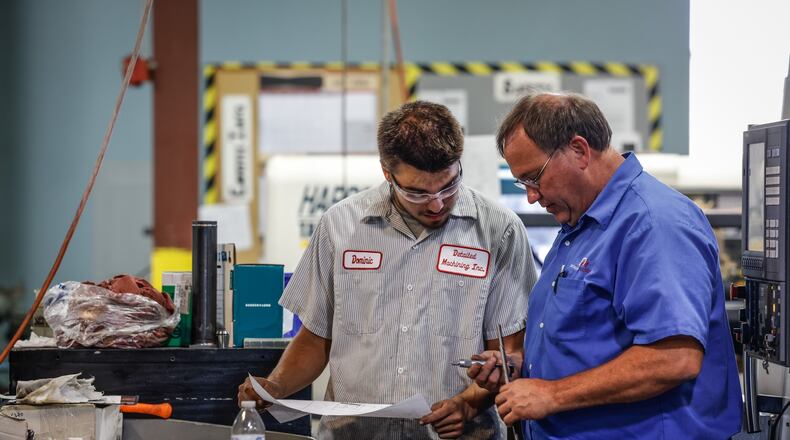There are signs that inflation, in some sectors, is moderating. No one who spoke with the Dayton Daily News for this story was panicking. Instead of precipitous falls in orders, business leaders say they’re seeing a general slow-down. Instead of laying off workers, they say they’re more selective in hiring.
The focus is managing the challenge, not surrendering to it.
“I’ve been in business for more than 25 years. I’ve learned not to lose sleep over things,” said John Bertsch, president and chief executive of Detailed Machining in Sidney.
“I’m kind of an optimistic guy as a general rule,” said Jim Bowman, president and CEO of Noble Tool Corp. in Dayton.
The Consumer Price Index hit a year-over-year increase of 9.1% in June, up 1.3% from May, the fastest annual rise since late 1981, according to federal numbers released in mid-July. (The next CPI report is due Wednesday. )
In a four-state region that includes Ohio, inflation is even hotter, nearly 10% in June, compared to June 2021.
‘Higher interest rates are giving people pause’
Higher interest rates are part of the pain as the Federal Reserve tries to slow inflation. On July 27, the Fed raised interest rates for the fourth time in five months.
Higher rates affect everyone using a credit car, buying a car or home. Nationwide, sales of existing homes have dropped for five months. In the Dayton area, sales of single-family homes and condominiums reached 1,596 in June, a fall of almost 8% from June 2021, according to the Dayton Realtors trade organization.
Donna Darner, 54, rents in Kettering with her husband. They’re looking to buy a larger three-bedroom house not too far from where she works for Moraine city government.
“I’m seeing houses I really want, and I know I can’t afford especially because of the interest rates,” Darner said.
It’s still very much a seller’s market, said Eric Groff, a Realtor with NavX Realty and Darner’s agent. But he detects a “softening” of that. Homes that may have sold in 48 hours or less three months ago now may be on the market for 10 to 15 days, he said.
“I think these higher interest rates are giving people pause,” he said. “They’re a little bit more selective.”
The 30-year fixed mortgage rate averaged 5.52% as of Aug. 4 — down slightly from the week prior. A year ago, mortgage rates averaged 2.80%.
Renters aren’t being spared. According to Rent.com, the average rent for a studio apartment in Dayton is $875 as of July, up 16% since July 2021. The average rent for a one-bedroom apartment here is $962, up 4% over the same time period. (Rent for a three-bedroom apartment, however, is down 1% to $990.)
Price stabilization?
But it’s complicated. Some observers say they detect a slight stabilization, at least with some prices.
“It’s a weird market right now to try to manage,” said Chuck Dryer, territory manager for Kent-based Industrial Tube and Steel, which also has a presence in Butler County’s West Chester Twp..
That all-important regular expense, gasoline, has been falling in price. Gas prices have fallen for 49 straight days, as of Aug. 2. In Ohio, the average price of a gallon of regular unleaded was $3.87 as of Aug. 3, according to the Oil Price Information Service.
Still, that average even then was $1 or more than last year at about the same time.
Food remains expensive, but there are signs inflation there is moderating. U.S. consumer food prices were up 10.4% in June from the previous June, but global wheat and corn prices have fallen in recent weeks.
‘Trying to hold the line’
Noble Tool’s Bowman said he has seen few major challenges in securing the primary components he needs, such as cold-rolled steel and aluminum.
The biggest challenge is more on the maintenance side, he said. If a motor goes out, it may or may not have been of overseas origin originally.
This spring and early summer, prices were rising so fast that job quotes could quickly become outdated. Bowman said he is trying to hold quoted prices steady for 60 days to 90 days.
“That’s getting to be a bit of a stretch, and it’s kind of crunching into our margins,” he said. “But we’re taking the risk that we would rather hold our prices, because we quote each job.”
Chuck Dryer, of Industrial Tube and Steel, has watched material prices go up from his supplier. Like Bowman, he lives — and sweats — in the gap between when a customer places an order and when his company receives the material to fill that order. Prices can go up in the interim.
“So you’re constantly trying to balance and keep them (customers) updated on what’s going on,” Dryer said.
“We’ll try to eat some of it (the most recent price increase) if we can,” he added.
A year ago, these fast increases might have come as a shock. These days, more customers seem to be numb to it, Dryer said.
Help wanted — still
The war in Ukraine brought on three base price increases just in March alone in the cost of structural steel, a cost that went up about $550 a ton, Dryer said. At the end of 2021, there had actually been price decreases.
But as of early- to mid-July, there appeared to be some stabilization at work in prices, although changes in availability of materials can still be an issue, he said.
The result is customers can be a little “gun-shy,” Dryer said.
Dryer’s company is not contemplating layoffs, and he sees a desire for qualified workers wherever he travels.
“I cover Dayton, Columbus, Indianapolis, and I see about 15 to ‘help wanted’ signs a day,” he said.
Detailed Machining is also taking applications. Bertsch said in late July he needed to fill a couple of positions.
But he’s being choosy about his hires.
“We’re kind of picking and choosing a little better,” he said.
‘We accidentally insulated ourselves’
Beth Flippo, CEO of Drone Express, said supply chain hassles and inflation have actually worked to the advantage of her young drone delivery and logistics business.
Because Drone Express had to keep its drones and its components mostly made in the United States, it was able to avoid the delays and kinks that were slowing overseas shipping to other companies, Flippo said.
“We accidentally insulated ourselves,” she said. “I would love to take credit for that, but we’re actually in a great position because these aircraft (Drone Express drones) have to be produced in the United States, we got very lucky.”
When will inflation end?
Rea Hederman — executive director of the Economic Research Center and vice president of policy at the Buckeye Institute think tank — is bearish on the idea that the end of of inflation is anywhere near.
He cautions that drops in food and gas prices reflect sectors where prices tend to rise and fall quickly. And he sees a chance of “structural inflation” becoming entrenched as upward pressure on workers’ wages is felt.
“The causes of inflation have started to change,” he said.
Inflation caused by supply chain pressures are starting to ease. Now inflation is happening in services — child care providers, restaurant meals, haircuts and other services.
More workers have been willing to move on to new jobs during what has been called the “Great Resignation.” In response, some employers raised wages.
“That creates an almost structural inflation where wages and prices are going up in tandem,” Hederman said. “The bad news for workers is that wage increases are not keeping pace with price increases.”
He sees inflation being a problem until at least next year.
“The more permanent areas of inflation have continued to increase at a more rapid rate.”
Unmatched coverage
The Dayton Daily News will examine how inflation is impacting the region over the next three Sundays.
Today: Business supply chain costs, employee hiring and interest rate hikes felt locally.
Aug. 14: Costs to build that local school building, roadway or new bridge are skyrocketing, causing delays.
Aug. 21: That hamburger, milk or new schools supplies cost more. What inflationary costs are doing to our purchasing power in Dayton region.
About the Author

